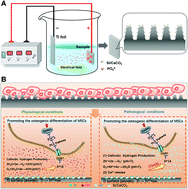Osteogenic differentiation of mesenchymal stem cells by silica/calcium micro-galvanic effects on the titanium surface†
Abstract
Based on the sensitivity to the extracellular H+ concentration of proton-sensing receptors, we immobilized Si/CaCO3 nanoparticles on a titanium surface (TiMNPs) by using micro-arc oxidation (MAO) to produce micro-galvanic effects by Schottky contact, aiming to regulate the hydrogen evolution reaction of micro-galvanic couples and osteogenic response of mesenchymal stem cells (MSCs). The surface zeta potential measurement and dynamic potential polarization test confirmed that micro-galvanic effects were successfully produced on the titanium surface after the treatment of Si/CaCO3 nanoparticles. The Ti substrate with a Si/CaCO3 nanoparticle loading concentration of 100 mg mL−1 (TiMNPs 100) could lead to the highest level of hydrogen evolution reaction. In vitro experiments showed that TiMNPs 100 were significantly superior in their ability to down-regulate the expression level of proton-sensing receptors and key proteins in the PLC/Ca2+ signal pathway, which in turn promoted MSC osteogenesis differentiation. A higher level of ALP activity, mineralization capacity and collagen secretion on TiMNPs 100 was confirmed as compared to those of other groups. This study provides a new insight into designing novel biomaterials for bone generation.



 Please wait while we load your content...
Please wait while we load your content...